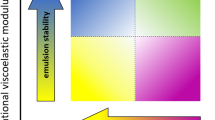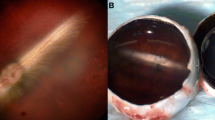Abstract
• Background: To determine the importance of chemical stability and purification of perfluorocarbon liquids (PFCLs) in experimental retinal tolerance, we tested four different substances as long-term vitreous tamponade: purified and nonpurified perfluorodecalin (PFD) and perfluoro-octylbromide (PFOB) • Method: After mechanical vitrectomy we replaced the vitreous of 65 rabbit eyes. Five groups were formed; four of them received the four PFCLs, while one served as control and received Ringer solution. The eyes were observed clinically every week and examined histologically after 1, 2, 4 and 8 weeks • Results: After 1 week we observed foam cells and intraretinal macrophages in all eyes with PFCLs. Purified PFD caused retinal lesions in the photoreceptor, ganglion cell and outer nuclear layers after only 2 weeks in the lower part of the eyes. In eyes filled with purified PFOB we observed more pronounced damage of the same nature. Unpurified substances caused severe inflammation and retinal detachment • Conclusion: Our study demonstrates that purification and chemical stability are important factors in retinal tolerance of PFCLs for vitreous replacement. Although purified PFD was tolerated by the rabbit eyes for 1 week, we cannot recommend this substance for short-term clinical use as a vitreous substitute.
Similar content being viewed by others
References
Baldinger J, Doft BH, Burns SA, Johnson B (1986) Retinal toxicity of amphotericin B in vitrectomised versus nonvitrectomised eyes. Br J Ophthalmol 70:675–661
Bottoni F, Sborgia M, Vinciguerra P, Zenoni S, De Molfetta V (1992) Perfluorodecalin and perfluorophenanthrene as post-operative short-term vitreous replacement. J Vitreoretina 1:37–41
Chang S (1987) Low viscosity liquid fluorochemicals in vitreous surgery. Am J Ophthalmol 103:38–43
Chang S, Zimmermann NJ, Iwamoto T, Ortiz R, Faris D (1987) Experimental vitreous replacement with perfluorotributylamine. Am J Ophthalmol 103:29–37
Chang S, Sparrow JR, Iwamoto T, Gershbein A, Ross R, Ortiz R (1991) Experimental tolerance to intravitreal perfluoro-n-octane liquid. Retina 11:367–374
Eckhardt C, Nicolai U, Winter M, Knop E (1991) Experimental intraocular tolerance to liquid perfluorooctane and perfluoropolyether. Retina 11:375–384
Glaser MB, Carter JB, Kuppermann BD, Michels RG (1991) Perfluoro-octane in the treatment of giant retinal tears with proliferative vitreoretinopathy. Ophthalmology 98:1613–1621
Irvine DW, Johnson MW, Hernandez E, Olson K (1991) Retinal toxicity of human tissue plasminogen activator in vitrectomised rabbit eyes. Arch Ophthalmol 109:718–722
LeMer Y, Kroll P (1991) Die Anwendung von flüssigem Perfluorocarbon bei Riesenrissen. Klin Monatsbl Augenheilkd 198:264–267
Meinert H (1992) Requirements of perfluorocarbons for use in ophthalmology. J Vitreoretina 1:5–16
Miyamoto K, Refojo MF, Tolentino FI, Fournier GA, Albert DM (1984) Perfluoroether liquid as a long-term vitreous substitute. Retina 4:264–268
Nabih M, Peyman GA, Clark LC Jr, Hoffmann RE, Miceli M, Abou-Streit M, Tawakol M, Liu K (1989) Experimental evaluation of perfluorophenanthrene as a high specific gravity vitreous substitute: a preliminary report. Ophthalmol Surg 20:286–293
Obraztsov VV, Kabalnov AS, Makarov KN, Gross U, Radeck W, Rüdiger S (1993) On the interactions of perfluorochemical emulsions with liver microsomal membranes. J Fluorine Chem 63:101–111
Shapiro MJ, Resnick KI, Kim SH, Weinberg A (1991) Management of the dislocated crystalline lens with a perfluorocarbon liquid. Am J Ophthalmol 112:401–405
Sparrow JR, Otiz R, MacLeish PR, Chang S (1990) Fibroblast behaviour at aqueous interfaces with perfluorocarbon, silicone, and fluorosilicone liquids. Invest Ophthalmol Vis Sci 31:638–646
Terauchi H, Okinami S, Kozaki Z, Tanihara H, Nagata M, Segawa Y (1989) Experimental study on the effects of a replacement of the vitreous body with perfluorotributylamine on the rabbit eye. (in Japanese) Nippon Ganka Gakkai Zasshi 93:294–301
Author information
Authors and Affiliations
Rights and permissions
About this article
Cite this article
Velikay, M., Stolba, U., Wedrich, A. et al. The effect of chemical stability and purification of perfluorocarbon liquids in experimental extended-term vitreous substitution. Graefe's Arch Clin Exp Ophthalmol 233, 26–30 (1995). https://doi.org/10.1007/BF00177782
Received:
Revised:
Accepted:
Issue Date:
DOI: https://doi.org/10.1007/BF00177782




